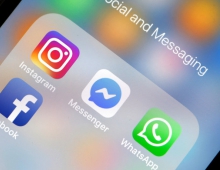
Facebook Releases More User Data to Health Researchers
Facebook Inc. is expanding the user location data that the company offers to researchers and non-profits trying to study the outbreak of the Covid-19 coronavirus.
The company will also start surveying some U.S. users about their health as part of a Carnegie Mellon University research project aimed at generating “heat maps” of self-reported coronavirus infections.
"Flattening the global COVID-19 curve is a challenge that takes all of us. As people distance themselves to protect their communities and healthcare workers save lives on the front lines, hospitals are working to get the right resources, and public health systems are looking to put the right guidelines in place. To do that, they need better information on whether preventive measures are working and how the virus may spread," Facebook said.
The world’s largest social network shares anonymized, aggregated location information as part of an effort to study disease outbreaks, and more than 150 organizations partner with the company to use that data for research. Facebook is adding new data points for researchers fighting Covid-19, including information about whether people are staying at home, and other material that details “the probability that people in one area will come in contact with people in another,” the company said Monday.
As part of Facebook’s Data for Good program, Facebook offers maps on population movement that researchers and nonprofits are already using to understand the coronavirus crisis, using aggregated data. The new tools to support their work include three new types of Disease Prevention Maps to help inform disease forecasting efforts and protective measures.
Facebook's Disease Prevention Maps are aggregated sets of information that health researchers can use to better understand how population dynamics influence the spread of disease. Facebook is sharing three new tools.
Co-location maps reveal the probability that people in one area will come in contact with people in another, helping illuminate where COVID-19 cases may appear next.
Facebook's movement range trends show at a regional level whether people are staying near home or visiting many parts of town, which can provide insights into whether preventive measures are headed in the right direction.
The social connectedness index shows friendships across states and countries, which can help epidemiologists forecast the likelihood of disease spread, as well as where areas hardest hit by COVID-19 might seek support.
Disease Prevention Maps aggregate information from Facebook, and Facebook says it takes additional steps to obscure people’s identities and reduce the risk that anyone could be re-identified. For example, Facebook's datasets can show information at a city or county level, not the patterns of individuals.
Starting today in the US, some people will see a link at the top of News Feed to an optional, off-Facebook survey to help health researchers better monitor and forecast the spread of COVID-19. The survey — run by Carnegie Mellon University Delphi Research Center — will be used to generate new insights on how to respond to the crisis, including heat maps of self-reported symptoms. This information can help health systems plan where resources are needed and potentially when, where and how to reopen parts of society. If the results are helpful, Faebook will make similar surveys available in other parts of the world.
CMU Delphi Research says it will not share individual survey responses with Facebook, and Facebook won’t share information about who you are with the researchers. Facebook will share a random ID number that CMU will send back to the social networking company when someone completes the survey. Then we’ll share a single statistic known as a weight value that doesn’t identify you but helps correct for any sample bias.
Google said last week it would publicly release mobility reports that show anonymized data about where people are traveling to help researchers better track the disease. The company’s Maps app is used by more than 1 billion people worldwide.





















